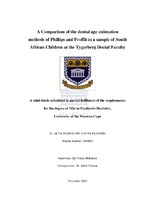| dc.contributor.advisor | Mohamed, Nadia | |
| dc.contributor.advisor | Hudson, Athol | |
| dc.contributor.author | Elgamri, Alya Isam Eldin Gafar | |
| dc.date.accessioned | 2016-06-02T10:43:29Z | |
| dc.date.available | 2016-06-02T10:43:29Z | |
| dc.date.issued | 2015 | |
| dc.identifier.uri | http://hdl.handle.net/11394/5036 | |
| dc.description | Magister Scientiae Dentium - MSc(Dent) | en_US |
| dc.description.abstract | Background: Dental age is an indicator of the physiological maturity of growing children. Different methods for estimating the dental age in comparison to the chronological age were proposed in the literature. Objective: The aim of this study was to compare the accuracy of two methods i.e. the Phillips and Proffit methods in estimating the dental age in a sample of South African children at the Tygerberg dental faculty. Methods: A retrospective study was conducted by randomly selecting 100 panoramic radiographs with known chronological age. The sample contained an equal number of girls and boys (50 in each group) and the chronological age ranged between 6 and 11 years. Dental age for each radiograph was estimated using the Phillips and the Proffit methods respectively. The mean difference between dental and chronological age was calculated. Dental and chronological ages were compared using overall bias and random errors. Results: The results showed that for the girls’ sample, the Phillips method underestimated the age by 4 months which is statistically significant (p-value =0.03). The Proffit method underestimated the age by 2 days which is not statistically significant (p-value =0.97). Both methods however have the same frequency of random errors. For the boys’ sample, Phillips’ method underestimated the age by 6 months which is statistically significant (p-value <0.0001). Proffit’s method underestimated the age by 2 months which is not statistically significant (p-value= 0.15). The Phillips method was shown to have fewer random errors in boys. Discussion: The above mentioned results showed that for dental age estimation for girls, Proffit’s method would be more appropriate. This rationale is explained by the conclusion that it only underestimates the age by 2 days and has the same frequency of random errors as Phillips’ method. However, if one had to choose between the two methods for boys, the situation should be evaluated carefully. For boys, the Phillips method has fewer random errors but a larger overall bias (6 months) whereas Proffit’s method has more random errors but less overall bias (2 months). The choice between the two methods should therefore depend on the purpose of the estimation. If the method is used for estimating the age in a single individual with an unknown chronological age, Phillips’ method would be more preferable. However, if the method is used for age estimation in populations with a known mean chronological age, Proffit is preferred. Conclusion: Proffit’s description for dental development has been shown to be accurate in estimating the DA. It may therefore be considered to be a legitimate DA estimation method and not just a developmental description for the dentition. | en_US |
| dc.language.iso | en | en_US |
| dc.publisher | University of the Western Cape | en_US |
| dc.subject | Dental age | en_US |
| dc.subject | Physiological age | en_US |
| dc.subject | Chronological age | en_US |
| dc.subject | Panoramic radiograph | en_US |
| dc.subject | Phillips tables | en_US |
| dc.title | A Comparison of the dental age estimation methods of Phillips and Proffit in a sample of South African children at the Tygerberg Dental Faculty | en_US |
| dc.rights.holder | University of the Western Cape | en_US |

